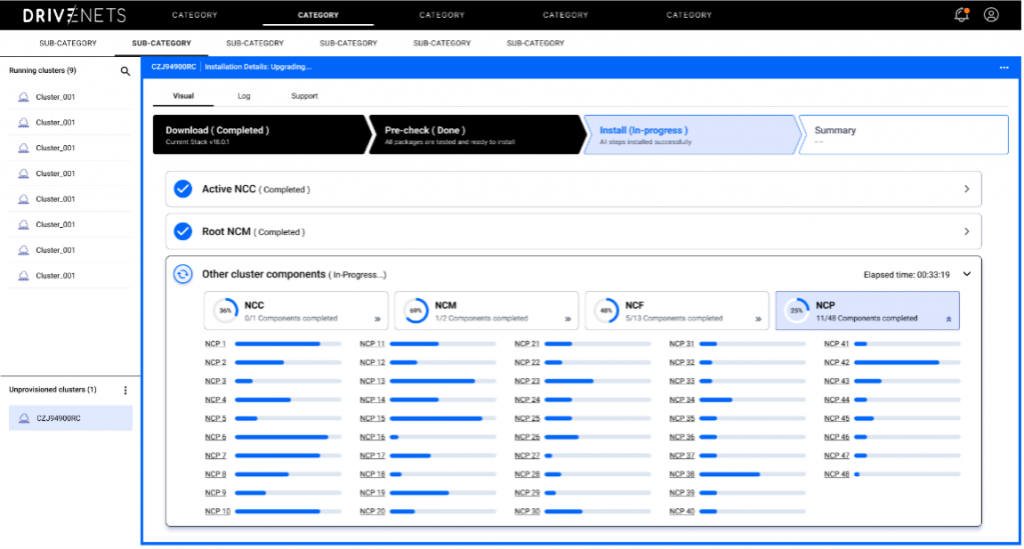What Is Zero Touch Provisioning (ZTP)?
Zero-touch provisioning (ZTP) has become increasingly important for telco service providers (SPs) in recent years. ZTP is an automated mechanism that allows new, unconfigured devices to be configured automatically upon powering up during deployment. This means that new network devices (such as routers, switches, etc.) can be deployed remotely without the need for on-site skilled IT personnel to manually configure them.
As networks grow in complexity and scale, managing thousands of different network devices across distributed environments has become a significant challenge for SPs. ZTP has emerged as a game-changer in network management as it can change the way network devices are deployed and configured, offering significant benefits in terms of time, reliability, and cost. This is especially true for tier-1 SPs managing large-scale networks with thousands of edge units and more at the access.
How does ZTP work?
Although ZTP implementations may vary, they all share the following fundamental steps:
- Device discovery: Once a new device is connected to the network, it automatically attempts to connect to a predefined ZTP server using factory-installed software.
- Configuration download: Once connected, the device downloads the latest configuration image from the ZTP server.
- Software installation: Using the downloaded configuration image, the necessary software and firmware are automatically installed on the device, making it fully operational without human intervention.
Why use ZTP?
Before ZTP, each device required manual configuration, typically done by on-site skilled IT personnel. Operational teams had to connect to the device using a command-line interface (CLI), manually load the necessary configuration, and then verify that it worked properly. This method is unmanageable in large-scale networks, especially when operational teams are limited in size and need to focus on more strategic tasks.
Key benefits of ZTP include:
- Simple and fast large-scale deployments: New devices can be deployed and configured in a matter of minutes, rather than hours or days.
- Eliminated human error: ZTP ensures consistent and accurate device configuration.
- Reduced costs: ZTP reduces operational costs associated with skilled on-site personnel.
- Improved scalability: SPs can handle any large-scale deployment required.
- Centralized managemenet: ZTP is typically managed through a centralized control system that provides enhanced visibility across all network devices.
Challenges of ZTP
While ZTP offers numerous advantages, there are also potential challenges:
- Initial setup complexity: While ZTP simplifies network device deployment, the initial setup can be complex. Planning the provisioning templates, automation scripts, and policies that ZTP will use has to be flexible and compatible with all possible scenarios.
- Legacy devices: ZTP may not support legacy devices; this can result in additional costs associated with replacing older infrastructure with new network elements.
- Troubleshooting and diagnostics: If a device fails to provision correctly through ZTP, diagnosing the problem can be more challenging without on-site skilled IT presence.
- Reliance on network connectivity: In remote locations with limited access, ZTP can become a challenge. If a device cannot connect to the server, it won’t be able to download its configuration image, defeating the purpose of ZTP.
- Security: An unsecured ZTP connection could expose a device to vulnerabilities or unauthorized remote access.
DriveNets and ZTP
The DriveNets Network Cloud leverages proven virtualization and disaggregation techniques employed by hyperscalers to build high-scale networks in a new way – detaching network growth from network cost and increasing network profitability.
DriveNets Network Cloud breaks traditional large routers into building blocks and runs cloud-native software on top of their components. It uses a Distributed Disaggregated Chassis (DDC) architecture to build any network use case, from core to edge. DDC clusters consist of dozens of white boxes functioning as a single routing entity.
Without ZTP, deploying such clusters would be a significant challenge. Instead, SPs are offered a streamlined process to bootstrap new clusters as fully functional routers to the network. Using the DriveNets Network Orchestrator (DNOR) user interface, SPs can easily plan a cluster. After connecting the new elements to the network, DNOR will automatically configure all the different white boxes with the correct configuration via ZTP, rapidly creating any necessary network element regardless of its size or complexity.
Historically, service providers have relied on monolithic solutions with integrated software and hardware platforms for their networking needs. ZTP bridges the operational gap and enables a disaggregated solution with a simpler user experience.

Key Takeaways for ZTP
Zero-touch provisioning is a powerful tool that can significantly enhance network management efficiency and agility, especially for large-scale SPs. By automating the device provisioning process, SPs can reduce costs, accelerate deployment speed, and improve reliability. With the shift to more scalable and open networks ZTP is expected to become an increasingly essential element for building network infrastructure.
Additional Resources about Zero Touch Provisioning (ZTP)
-
- Automating Service Provider Networks
- A True End-to-End Disaggregated Network Architecture
- Why Service Providers Are Rethinking Network Architecture
- Ensuring Smooth Deployment for the Disaggregated Model
- Zero Touch Provisioning ZTP is even more critical for Disaggregated Networks running on White Boxes





